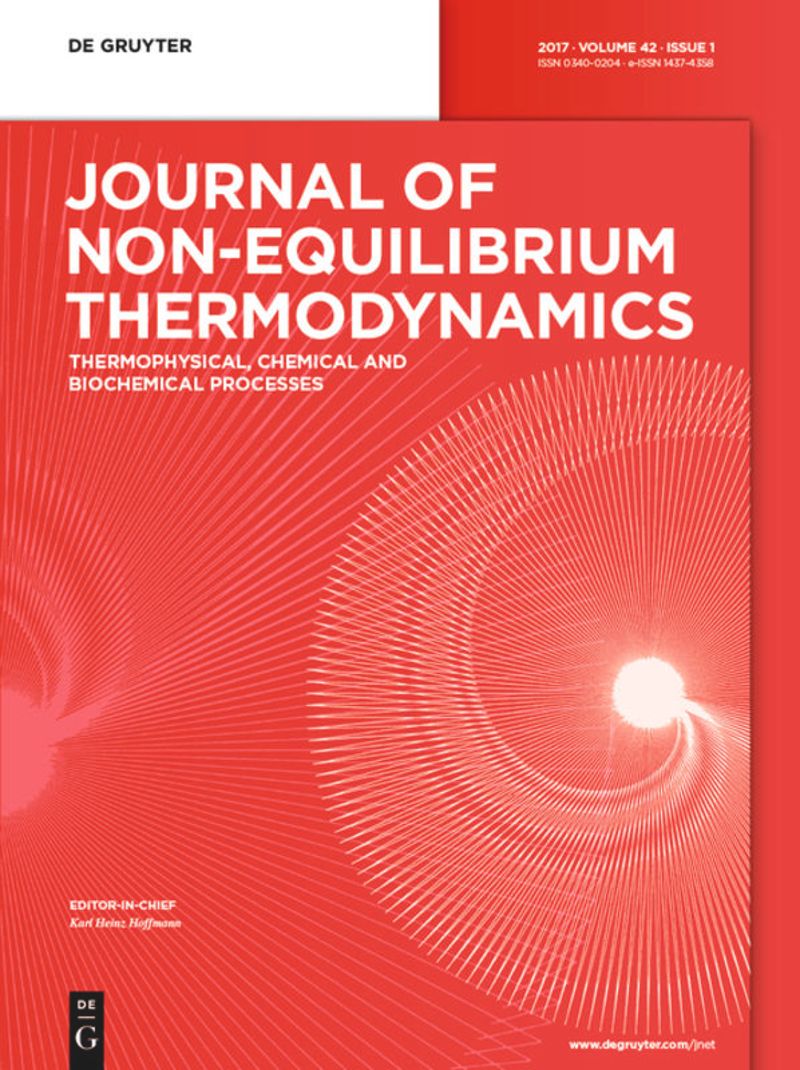A variational principle for extended irreversible thermodynamics: heat conducting viscous fluids
IF 4.2
3区 工程技术
Q1 MECHANICS
引用次数: 0
Abstract
Extended irreversible thermodynamics is a theory that expands the classical framework of nonequilibrium thermodynamics by going beyond the local-equilibrium assumption. A notable example of this is the Maxwell–Cattaneo heat flux model, which introduces a time lag in the heat flux response to temperature gradients. In this paper, we develop a variational formulation of the equations of extended irreversible thermodynamics by introducing an action principle for a nonequilibrium Lagrangian that treats thermodynamic fluxes as independent variables. A key feature of this approach is that it naturally extends both Hamilton’s principle of reversible continuum mechanics and the earlier variational formulation of classical irreversible thermodynamics. The variational principle is initially formulated in the material (Lagrangian) description, from which the Eulerian form is derived using material covariance (or relabeling symmetries). The tensorial structure of the thermodynamic fluxes dictates the choice of objective rate in the Eulerian description, and plays a central role in the emergence of nonequilibrium stresses – arising from both viscous and thermal effects – that are essential to ensure thermodynamic consistency. This framework naturally results in the Cattaneo–Christov model for heat flux. We also investigate the extension of the approach to accommodate higher-order fluxes and the general form of entropy fluxes. The variational framework presented in this paper has promising applications in the development of structure-preserving and thermodynamically consistent numerical methods. It is particularly relevant for modeling systems where entropy production is a delicate issue that requires careful treatment to ensure consistency with the laws of thermodynamics.扩展不可逆热力学的变分原理:导热粘性流体
扩展不可逆热力学是一种超越局部平衡假设,扩展非平衡热力学经典框架的理论。一个值得注意的例子是麦克斯韦-卡塔尼奥热通量模型,该模型在热通量对温度梯度的响应中引入了一个时间滞后。本文通过引入以热力学通量为自变量的非平衡拉格朗日量的作用原理,推导出扩展不可逆热力学方程的变分公式。这种方法的一个关键特征是,它自然地扩展了汉密尔顿的可逆连续介质力学原理和早期经典不可逆热力学的变分公式。变分原理最初是在材料(拉格朗日)描述中表述的,欧拉形式是利用材料协方差(或重新标记对称性)推导出来的。热力学通量的张量结构决定了欧拉描述中客观速率的选择,并在非平衡应力的出现中起着核心作用——由粘性和热效应引起——这对确保热力学一致性至关重要。这个框架自然产生了热通量的卡塔内奥-克里斯托夫模型。我们还研究了该方法的扩展,以适应高阶通量和熵通量的一般形式。本文提出的变分框架在结构保持和热力学一致数值方法的发展中具有广阔的应用前景。它与系统建模特别相关,其中熵产生是一个微妙的问题,需要仔细处理以确保与热力学定律的一致性。
本文章由计算机程序翻译,如有差异,请以英文原文为准。
求助全文
约1分钟内获得全文
求助全文
来源期刊
CiteScore
9.10
自引率
18.20%
发文量
31
审稿时长
1 months
期刊介绍:
The Journal of Non-Equilibrium Thermodynamics serves as an international publication organ for new ideas, insights and results on non-equilibrium phenomena in science, engineering and related natural systems. The central aim of the journal is to provide a bridge between science and engineering and to promote scientific exchange on a) newly observed non-equilibrium phenomena, b) analytic or numeric modeling for their interpretation, c) vanguard methods to describe non-equilibrium phenomena.
Contributions should – among others – present novel approaches to analyzing, modeling and optimizing processes of engineering relevance such as transport processes of mass, momentum and energy, separation of fluid phases, reproduction of living cells, or energy conversion. The journal is particularly interested in contributions which add to the basic understanding of non-equilibrium phenomena in science and engineering, with systems of interest ranging from the macro- to the nano-level.
The Journal of Non-Equilibrium Thermodynamics has recently expanded its scope to place new emphasis on theoretical and experimental investigations of non-equilibrium phenomena in thermophysical, chemical, biochemical and abstract model systems of engineering relevance. We are therefore pleased to invite submissions which present newly observed non-equilibrium phenomena, analytic or fuzzy models for their interpretation, or new methods for their description.

 求助内容:
求助内容: 应助结果提醒方式:
应助结果提醒方式:


